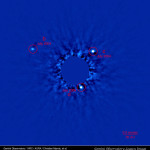Spot naked-eye exoplanet host stars!
Want to see something new in the night sky? To date, more than 700 exoplanetary systems have been identified in our local sector of the Milky Way. Most of these exoplanetary systems are associated with faint telescopic objects, but we’ve put together a list of 62 host stars that are magnitude 6 or brighter and can be readily reconnoitered without any optical aid at all. Point out some of the stellar hosts out at your next star party, and wave hello – someone may be waving back.
A K-band (2.2microns) AO image of the HR 8799 planetary system in Pegasus, made using Gemini/Altair/NIRI and acquired on September 5, 2008 (North is up and East is left). The three planets are designated with red circles. HR8799 is third from the end in our list of naked-eye exoplanet host stars. See Appendix 1. Image Credit: Gemini Observatory/ NRC/ AURA/ Christian Marois, et al. Click on image for a larger view.
The Gemini twin Pollux tops our list of easily-visible host stars. This first-magnitude orange giant star has at least one planet, a “hot Jupiter” that orbits perilously close to its stellar host. Gamma Leonis (Algieba), the 2nd magnitude star at the base of Leo’s neck, has at least one planet, possibly two. Epsilon Tauri, the 3rd magnitude star at the tip of the Hyades “V” opposite Aldebaran, also has a planet. Gamma Cephei can be easily spotted — it’s the Magnitude 3.2 star at the peak of the “house” making up the Cepheus house asterism. This star, actually a close binary with Gamma Cephei A, hosts at least one planet.
At magnitude 4, Upsilon Andromedae sports a planetary system with at least 3 planets, and one of them orbits inside the star’s habitable zone. A quick online search will get you a chart. Magnitude 3.7 Iota Draconis has a planet in a highly elliptical orbit. Any denizens on this hapless planet would periodically freeze and fry. Like Pollux, magnitude 4.5 Tau Bootis and nearby 5th magnitude 70 Virginis both host hot Jupiters. A bit more of a challenge in bright skies, 51 Pegasi at magnitude 5.5 has a hot Neptune, and HR8799 (Peg) at magnitude 6 both have planets; 51 Peg b was one of the first exoplanet to be discovered around a sun-like star. 6th magnitude HR8799 (also in Pegasus) is among the dimmest in our list, but its 3 planets have been directly imaged! See the photo above; a quick internet search on Google will get you the charts.
At 6th magnitude, 55 Cancri may be a binocular object in bright skies, but is well worth hunting down. This star hosts a system of 5 planets, one of which orbits within the star’s habitable zone. The internet is awash with further information on these and other exoplanetary systems. The websites of the Planetary Society ( http://www.planetary.org/exoplanets/list.php ) and NASA’s PlanetQuest (http://planetquest.jpl.nasa.gov/ ) are especially helpful, as is Wikipedia , and http://exoplanets.org , with comprehensive listings, finding charts, and illustrations.

Thanks! That is a great idea and list, especially for teching astronomy in school. It gives the material more substance and relevance and forms a good base for discussions.